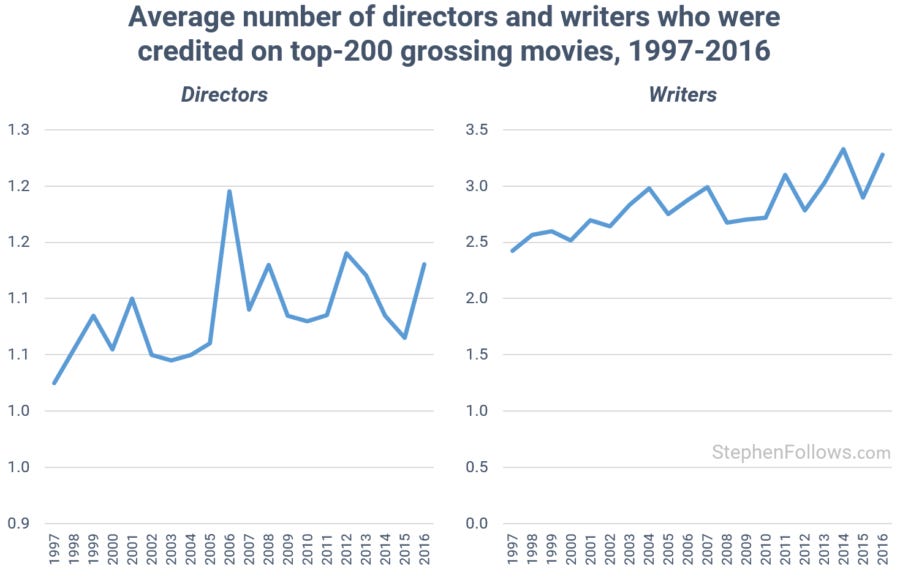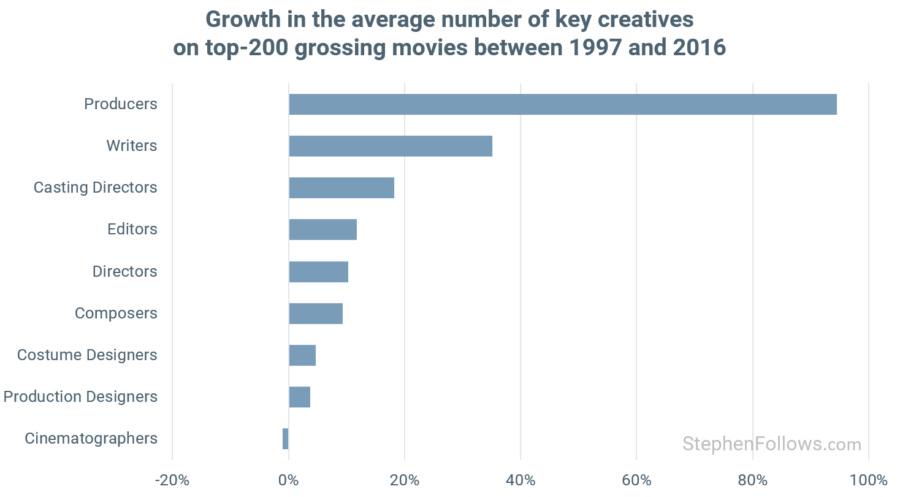How has the average Hollywood movie crew changed?

In the past, I’ve looked at how big a movie crew can get, for both UK films and Hollywood movies. But I was recently asked by a reader how the composition of such crews has changed over time. Which departments are getting larger? Which jobs are on the rise and which are waning?
To answer this, I looked at the credits of the top 200 US-grossing movies of each of the past 20 years (1997-2016), giving me a dataset of 4,000 movies.
The big picture
In the past two decades, the number of crew members on a top-grossing movie has grown by 77%, from 350 in 1997 to 620 in 2016.

If we group those crew credits into stages of production, we can see that a large amount of that growth has come in post-production jobs.
Over the studied period, jobs in pre-production and production (i.e planning and shooting the movie) grew by 53% but post-production jobs (i.e. getting the film from the shoot ready to be sold) grew by 129%.

N.B. "Other credited roles" include people thanked, accountants, craft services, medics, animal trainers, choreographers, etc.
Directors and writers

The Directors Guild of America (DGA) prevents signatories from making films with more than one credited director, meaning that the average number of movies with more than one director is fairly low.
In fact, fewer than 7% of films listed multiple directors, with the largest number of directors working on anthology features such as Paris, je t'aime (which credits 22 directors), Movie 43 (13) and New York, I Love You (11).
Writing credits are also regulated, although less tightly. The Writers Guild of America (WGA) permits up to three writers or writing teams on each movie. A writing team can have up to three members, meaning that the maximum number of writing credits on a WGA-approved feature is nine. This restriction does not apply to animated films, which is why Mulan was permitted to credit 32 people, The Lego Movie to have 31 and Wreck-It Ralph to have 28.
The average number of people credited as a director has increased by 10% (from 1.03 people in 1997 to 1.13 people in 2016). Writers have seen a bigger rise (35%), from 2.4 to 3.3 over the same period.

Producers
Producer credits are not regulated, so it's a more interesting and dramatic picture. The average number of producers has almost doubled over the past decade, from 6.1 in 1997 to 11.9 in 2016.
A large part of that rise has been due to the 168% rise in Executive Producers.

Every combination of producer credits seems to exist. In my research, I found co-executive producers (744 of them), associate co-producers (18), interactive producers (17 of them - implying that all other producers are just... static?), delegate producers (7), associate executive producers (6), producer liaison (4), a chief producer (1), an assistant associate producer (1), an assistant executive producer (1) and even a "special guest producer".
I fear for the poor runner who confuses the co-associate producer with the associate co-producer.
Other key creatives
It's not just the number of directors, writer and producers that is increasing. In fact, all major creative roles but one have increased over the past two decades.
The one hold-out is cinematographers. In 1997, the average movie had 1.015 cinematographers, whereas in 2016 the number had absolutely plummeted to just 1.005. Of all the major roles, it seems that the job of cinematographer is the least likely to be shared between multiple people, even less so than that of director.

In the past, I have looked at the increase over time of Assistant Directors and Editor credits so I won't go into detail here, but if you want to learn more then check out these articles: How many Assistant Directors work on UK and US movies? and How many editors does it take to edit a movie?
The growth in movie departments
Perhaps unsurprisingly, the department which has experienced the largest growth over the past two decades is Visual Effects.
Connected to this is the only department to have decreased in size - Special Effects. Visual effects are created digitally (computer generated effects and characters), while special effects are physical (wind, rain, explosions, etc).

Data
The data for today’s research came from IMDb, Wikipedia and The Numbers. I have used the US box office as the criteria because the numbers are more reliable (and complete) than that of the worldwide box office. I focused on the top 200 grossing films, rather than all films made or all films released, in order to be able to compare like with like.
The number of films being made and released each year is increasing rapidly and most of these extra productions are on the lowest budget range. So a study of all films would have to take account of budgets to prevent these from swamping the dataset and skewing the results. This research focuses on credits received, not seniority or time served. That means that someone who worked on a production for just one day counts the same as someone who was on the production for months. Also, if someone performed two jobs, they would count as two people, such as a director who also contributed to the screenplay.
You can read more about writer-directors here. In my first iteration of this research, I included 2017 but noticed a big drop across the board for 2017 films. After a little investigation, I discovered that this was a reporting error, rather than an industry-wide handbrake turn. So I chose to study films up to (and including) 2016, rather than 2017, as credits can take time to appear online.
A brief note about VFX credits
When studying visual effects jobs we need to remember that the traditional crediting system for crew members breaks down slightly. On many Hollywood movies, the visual effects shots are split up between multiple third-party VFX houses, in order to take advantage of each facility’s specialism(s) or to speed up the process. Once the film is complete, each facility is asked to put forward a list of names of people who worked on their shots to be added to the film’s official credits list.
However, in a large number of cases, the studio will put a limit on how many names each facility can submit. This means that some people who worked on the film won’t see their name in the end credits crawl and they won’t even initially appear as official credits in sites like IMDb. When this happens, the slighted crew members often submit their own credits to IMDb and, assuming they have sufficient proof to satisfy their checkers, their name will be added to the film’s credits page but with the phrase “uncredited” next to their job title.
I looked at the issues of “uncredited” credits a couple of years ago in an article entitled How many movies credits go uncredited?. In today’s research, I used both official and “uncredited” credits. It’s difficult to tell how many people are being left off either of these lists. Sites like IMDb serve a vital role in the industry to enable crew members to provide evidence of their experience and past employment. Therefore, I think it’s unlikely that large numbers of people are being left off the official credits list and don’t add their credits manually. However, this is an assumption on my part and one I’m happy to be given evidence on. If this feels like too much of a leap and you can help shed light on the scale of the issue, then please do get in touch or leave a comment below.
Epilogue
One question which comes up when discussing movie crew jobs is that of pay. In the past, I have looked at the pay of a few roles (1st AD, writers and on low-budget productions) but for a comprehensive overview, here are a few relevant links:
Hollywood's Salary Report 2017: Movie Stars to Makeup Artists to Boom Operators
How much everyone working on a blockbuster movie gets paid — from $148 to $12 million
Full List: The World's Highest-Paid Actors And Actresses 2017
Finally, I recommend watching the video below from Vanity Fair:


